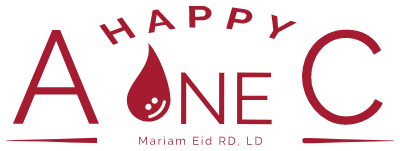The internet is loaded with misinformation about nutrition with so many uncredentialed people claiming to be nutrition experts. It can be so difficult to sift through the information and find practical, evidence-based nutrition advice. You may feel shocked, confused, and overwhelmed after receiving a pre diabetes diagnosis at a young age. You may feel as if your life was flipped upside down. You don’t know where to start, what to eat, and how to eat. I know those feelings all too well. The good news is that I’m here to provide you with the guidance and support to build up your nutrition knowledge and confidence with food. That starts with understanding how to manage insulin resistance with food and balance blood sugar levels. I know this may seem like too much science for a blog post you’re reading on the internet but it’s important to know how your blood sugar work because quite honestly, it’s fascinating and empowering. You’ll start to see how simple food changes can dramatically influence your sleep, ability to concentrate at school, studying abilities, energy throughout the day, mood, and mental clarity.

Goal with Prediabetes nutrition
Insulin resistance is at the heart of prediabetes. The idea is that the we want to decrease the amount of work insulin has to do after we eat. In an earlier post, we learned that after we eat, the carbohydrates we eat enter the bloodstream as glucose, and our blood sugar increases. Insulin receives a signal to be released as a response to the glucose increasing our blood sugar. Insulin’s job is to unlock the cell doors to allow glucose to flow into the cell so that they can use it to give us energy and bring down our blood sugar. This process is interrupted with prediabetes because of the cells resisting insulin– some cell doors are jammed. The goal with insulin resistance is to work towards increasing your cell’s responsiveness or ‘sensitivity’ to insulin so that the sugars can exit the blood, flow into the cells, and lower your blood sugar. Blood sugar balance is key to help increase your cell’s sensitivity to insulin and lower your A1C in the long run.
What is blood sugar balance?
One powerful way we can increase our cells’ ability to respond to insulin, i.e., insulin sensitivity, is by controlling the speed at which sugar lands into the blood stream after it is digested. Let me explain.
Every food we eat contains a unique combination of the “macronutrients” known as carbohydrates, protein, and/or fat. Understanding what foods fall into eat macronutrient is the first step towards achieving blood sugar balance. The unique combination of carbs, proteins, and fats determines the rate at which your blood sugar will increase, i.e., your blood sugar response. The simplest way to envision a blood sugar curve is to think of it like throwing a tennis ball. The higher you aim to throw a tennis ball, the more quickly it’ll shoot down. The more leveled the angle of your arm is when you throw the tennis ball, the softer it’ll land. For optimal blood sugar balance, we want a steady increase in blood sugar so that the sugar in your blood can eventually decrease at a steady rate.
How do different foods affect Blood sugar?
Sugars from carbohydrates have the strongest influence on increasing blood sugar levels. Protein slightly increases our blood sugar while fat has the least effect on our blood sugar response. This is why foods rich in carbohydrates and low in fiber, fat and protein, such as candies, bread, pasta, pastries, etc., are often vilified in people with prediabetes. It’s because these delicious foods have the strongest ability to spike your blood sugar. The sugar lands in your bloodstream quickly without fiber, fat, or protein holding it back. It’s almost as if, after the high sugar load is digested, the floodgates are opened and and your blood sugar spikes above normal limits (as shown on the below).
The body is not able to register exactly how much insulin needs to lower your blood sugar so it sends out more insulin than you need. After insulin transports the sugars in the blood into the cells and your blood sugar returns to normal, there is often leftover insulin in the blood. Insulin will continue to do its job and move sugars into your cells, which can bring down blood sugar to dangerously low levels. This is the scientific description of a blood sugar crash; it’s accompanied by feelings of fatigue, sleepiness, hunger, and irritation.
In other words, the steeper the rise in blood sugar, the more dramatic the fall about 1-2 hours later. The goal is to increase your blood sugar at a steady rate such that you avoid a spike and your blood sugar levels eventually normalize in a steady manner.

The graph here shows the average person’s blood sugar response to different types of food groups when eaten ALONE. The goal here is to control how quickly your blood sugar rises and falls such that it remains in the indicated optimal blood sugar level range.
This does NOT mean you should avoid eating low fiber carbs but rather, it suggests you can tweak how you eat those satisfying foods to support blood sugar balance. Refer to the discussion on carbohydrate pairing below to learn how to incorporate ALL these foods while balancing your blood sugar.
how to balance your blood sugar
Carb pairing
I’m sure a lingering thought in your head may be to restrict or remove carbs from your diet. I understand why you may be thinking that based on what we just reviewed. The good news is that I am NOT here to take carbohydrates out of the equation. I mean, can you imagine a life without bread, pasta, ice cream, cake? I can’t. Instead, we want to avoid eating carbs alone or “naked.” I want to introduce you to the idea of carb pairing. This involves “dressing up” your carbs with fat and protein to slow down the rate at which sugar lands into the blood stream.
We learned that fat and protein have the least effect on blood sugar. We can take advantage of their ability to slow down digestion and stabilize the blood sugar response. Since carbs increase our blood sugar, consuming fat and protein at the same time can help bring down the blood sugar peak, as shown above. This increases and decreases your blood sugar at a steady rate, allowing your blood sugar to return to normal levels without risking a blood sugar crash.
This principle is especially helpful for low-fiber carbs. Since they can spike your blood sugars when eaten alone, including fat and protein onboard supports balanced blood sugar levels, and enhanced energy and feeling of fullness throughout the day.That way, you can achieve emotional satisfaction by eating the carbs you love AND feel better physically and mentally after eating them.
I want you to do a little exercise with me. Look at your dominant hand. Make a fist as if you were going to punch someone. Now open it up and put the fingers of your other hand on your dominant hand’s palm. Now do a thumb’s up for me. For every fist-size of carbohydrates you eat, I want you to pair it with a palm-sized amount of protein and/or a thumb’s size of fat.
The main idea is that you avoid eating carbohydrates alone to avoid a blood sugar spike, have a more balanced blood sugar response, and achieve a happier A1C in the long run (PMID: 33747991). I encourage you to ask yourself how you feel when you eat carbohydrates alone versus when you practice carb pairing.
Examples of carbohydrate pairing include:
- 1 slice of white toast + thumb size of peanut butter
- Fist size of crackers + thumb size of full-fat cheese
- 1/2 bagel + 1 egg
Fiber
Fiber is a type of carbohydrate that is NOT absorbed into the blood and does not contribute to increasing blood sugar levels. It holds many health benefits including improving your poop cycle, lowering cholesterol levels, balancing blood sugar, and enhancing fullness. Fiber-rich foods, often called complex carbohydrates, include fruits, whole grains, starchy vegetables, beans, and legumes.
The most dense source of fiber is found in non-starchy vegetables, such as leafy greens, green beans, broccoli, cauliflower, etc. However, unlike the other fiber-rich foods listed above, non-starchy vegetables alone do NOT contain enough carbohydrates to fuel your body with adequate energy. Therefore, I always encourage you to as an opportunity to add more fiber to your meals instead of considering them a stand-alone carb source.
Fiber is complex and slows down the digestion and absorption of other nutrients eaten with it. Fiber-rich foods contain a mixture of fiber and absorbable sugars. The sugars in fiber-rich foods are absorbed more slowly into the bloodstream in the presence of fiber. This lowers the blood sugar peak & prevents a blood sugar spike
Think of fiber like a complex matrix; it requires more work to be digested than low-fiber carbohydrates. Since fiber-rich foods contain a mixture of fiber and absorbable sugars, the sugars in fiber-rich foods are absorbed more slowly and take longer to land in the bloodstream in the presence of fiber. As a result, it keeps you fuller for longer, lowers the blood sugar peak, and prevents a blood sugar crash (see image above).
If you want to take carbohydrate pairing to the next level, choose a fist size of complex carbohydrates and pair it with a palm size of fat and protein. Here are some examples:
- 1 apple + thumb size of nuts
- 1 slice of whole grain toast + 2 slices of turkey
- 1/2 cup of oatmeal + thumb size of peanut butter
If you’re feeling extra spicy, you can even add a handful of non-starchy vegetables to the mix for some extra fiber, such as okra, artichoke, beets, celery, tomatoes, or onions. Since non-starchy veggies fall between protein & less processed carbohydrates on the blood sugar curves, they can help further help in bringing down the blood sugar peak.
To explore more carbohydrate pairing examples, especially for snack choices during school and work hours, visit this page.
Non-food Factors that affect blood sugar
Stress management is key to managing blood sugar levels. There are many non-food factors to consider that can greatly affect your blood sugar. This includes dehydration, genetics, food timing, sleep quality and quantity, personal, school and work-related stress, anxiety and depression, smoking or vaping, gut health, hormonal health, and movement patterns (PMID: 29686462). Sleep is often one of the most overlooked factor in teens and young adults. Ensuring you get 7-8 hours of quality sleep every night is critical to your blood sugar health.
You can probably see how prediabetes extends beyond nutrition. It’s important to take a closer look at your lifestyle, identify primary stressors, and consider working with a licensed counselor to improve your mental health.
exercise/Activity and blood sugar
Exercise can be a powerful tool to help increase insulin sensitivity and lower blood sugar levels. When we engage our muscles, they drink up the sugars in the blood, leading to more stable blood sugar response in the long run. Many people have an all-or-nothing approach to exercise. Like nutrition, exercise can make a difference on your overall health in small quantities. In fact, a recent study showed that only as little as 10 minutes of movement per day can provide health benefits and decrease the risk of death.
Exercise is NOT meant to be militant punishment. The best exercise is NOT the one that will leave you exhausted. The best exercise for you is the one you find joy in and can remain consistent with.
Examples of PRACTICAL, Baby STEPS TOWARDS BLOOD SUGAR BALANCE
- Layer every carb choice with fiber, fat, and protein.
- Consider diluting soda with its sugar-free counterpart.
- Choose more whole grains, such as quinoa, bulgur, brown rice, wild rice, and oatmeal.
- Experiment with non-starchy vegetables to find your preferred taste and textures.
- Add 10-15 minutes of movement to your daily routine.
- Include at least one de-stressing routine into your day, such as journaling, meditation, or watching a comedy.
- Enhance your sleep hygiene so that you feel more refreshed and decrease the stress load on your body.
Finding your balance
We need ALL three macronutrients to achieve fullness, satisfaction, and nutrients. Every food, even the ones you love, can fit into your lifestyle as you aim to reverse prediabetes. The key is to find your balance with food and movement. This includes finding foods that physically AND emotionally satisfy you and consuming them in a way that makes you feel good and supports your wellness goals. Start with one small, realistic goal (such as one listed above) and remain consistent with it. Recognize if it’s sustainable for you to maintain and pinpoint what about it makes it less joyful to you. After a couple of tweaks and consistency, consider adding another small goal and repeat the process.

The main ingredient for finding your balance is consistency. It requires you getting to know yourself a bit more and realizing what works and does not work for you. Remember, health is NOT achieved overnight. Your health is the sum of small, feel-good changes you can maintain for the rest of your life.
Don’t forget to subscribe to our email list for a free handout with more examples of carbohydrate pairing!

whoah this weblog is magnificent i love reading your posts.
Keep up the great work! You recognize, a lot of persons are
looking round for this information, you can help them greatly.
Thank you! I’m so happy you’re finding it helpful! 🙂 I would highly appreciate it if you would share it with anyone who may benefit!
Hey there I am so grateful I found your weblog, I really found you by
accident, while I was searching on Digg for something else, Nonetheless I am here now
and would just like to say many thanks for a fantastic post and a all round enjoyable blog (I also love the theme/design),
I don’t have time to look over it all at the minute but I have
bookmarked it and also added in your RSS feeds, so when I have time I will be back to read more, Please do keep up the
fantastic work.
I greatly appreciate your kind feedback! I’m so grateful you’re finding it helpful. 🙂